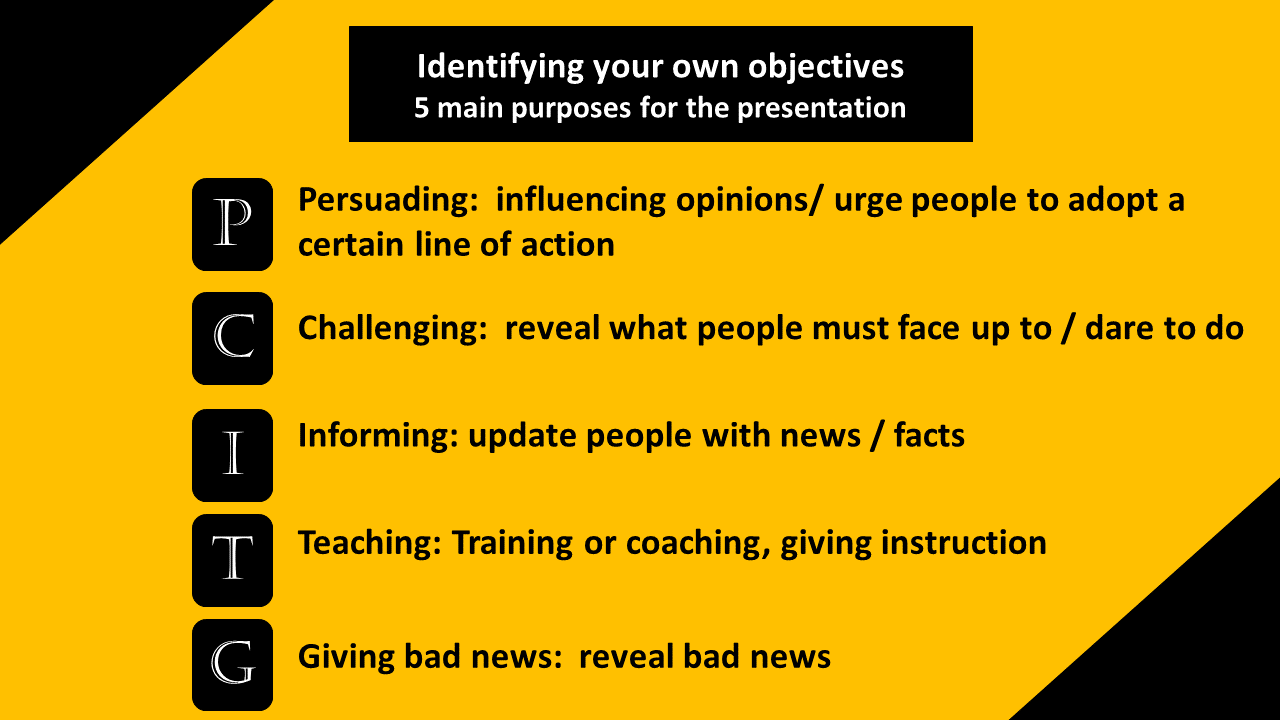
Identifying Your Own Objectives
If you are not clear about what you want to accomplish with your presentation, you are guaranteed to produce a vague and embarrassingly inept performance. Define what you want your audience to do as a result of your presentation. There are five main purposes for the presentation.

Yet your objective will still be that they do something as a result of attending the presentation. Specifically, what do you want to achieve? Try to narrow down your objective to one single strong sentence – that spell out exactly what it is that you want to achieve.
Identifying Your Audience’s Objectives
Try and get inside the mind of your audience.
It appears that a large crowd of people packed together in one place achieves two important results that still cannot be so well achieved by any other means: the affirmation of unity and solidarity, and the acclamation of leadership. This is not true of small gatherings, but as they grow larger it becomes more and more true. A really large audience is not, for most practical purposes, a place for detailed and reasoned argument. The more people there are, the smaller the proportion whose knowledge, experience, intelligence and interest are at the right level, and the harder it is for the argument to be comprehensible and relevant to any but a few. So you have to appeal not to the diverse minds but to the common emotions – hopes and fears, elation and aggression, admiration and contempt, shared experiences and shared aspirations. When you get so many people together, you are not dealing with the intellectual differences of the individual but with the biological identity of the species. In an audience, we discover our group identity and we accord special prominence and respect to those who lead us to the discovery.

In order to pitch your presentation at the right level and to establish the appropriate language level, you need to identify the type of audience that you will be addressing. Can you speak in a language that is understood by the audience? This is a question you should ask yourself before every lecture. Audience language means- ‘words that the audience use and understand’.
If your audience prefers pictures and simple language, give them exactly that. Other audiences, are familiar with technical words, so pitch your lecture at their level of understanding otherwise they may think you are insulting their intelligence.
The characteristics of the audience are extremely important:
- Size of the audience
- Gender
- Age
- Culture
- Ethnic background
- Political and religious beliefs
- Corporate culture
- Status and titles
Why is the audience there? Why must they attend the lecture?

Finally you should be able to formulate another key sentence – the one which expresses the final impression you want to leave in the mind of your audience when the presentation ends.
Click here to download questions to ask when preparing your presentation with the audience in mind.
The following questions might be helpful.
- What are they thinking about the subject?
- To be quite basic, how much do they already know about the subject – what is their level of technical interest and understanding? You will have to go into more details and explanations if they are relatively unfamiliar with what you are going to talk about.
- Why would they attend?
- What’s in it for them?
- If you try and look through their eyes, would they be attending with an expectation of you which you are not yet prepared for or able to meet?
- How interested would they be in your objective?
- What values do members of your audience hold?
- What is important to them? Be careful if you are trying to transfer a tried and tested presentation into a new type of audience.
- What needs do you believe the audience has?
- What internal political or financial constraints will limit their capacity to get involved with your proposals?
- Do they have a budget to finance the recommendations you are going to make?
- What do they think of you, as a result of previous interaction with you? Is there anything you must make sure to do differently?
- How many will be attending, that is, what size of group will you be addressing, and what will the venue be like?
Planning for the Duration of the Presentation
A lecturer may ask himself “how long does the subject need?”, but a presenter need to ask “ How long can the audience spare?”
Most people are worried that they will not have enough to say. There seems to be some sort of guilt about giving short measure. Consequently the great danger at this stage is of having too much to say.

In planning it could be helpful to mark the paragraphs of your script with A,B,C in terms of importance. Should your time run out you can easily cut the C paragraphs without sacrificing critical contents.
In planning your time keep in mind that the use of visual aids will “spread” your timing.
A presentation that runs too long upsets everybody. Should you not plan right and your presentation go to long you will find yourself going too fast, cutting on interesting, but less essential parts and consequently making the whole presentation more indigestible.
Selecting Techniques Most Applicable for the Specific Type of Presentation
A lecturer should not rely on a sole method of instruction. A well-structured lecture would have more than one method of delivery. Remember that variety is necessary, but don’t go overboard.
A presenter should not use more than two methods/techniques for presentation as this could confuse the audience and take up too much time.
The experienced lecturer/presenter will be able to look at a topic and decide on a number of methods that can be used independently, or in combination, for maximum benefit to the delegate.
The presenter must make the decision on which method to use of instructions based on the delegate’s requirements and not on what the presenter feels like doing.
Click here to download a handout on the techniques to use when presenting.